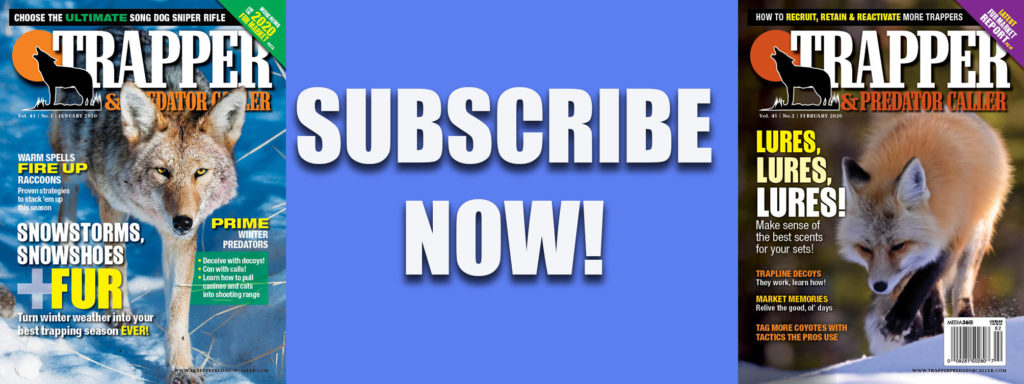
By T.R. Hendrick
The clock was ticking by the time I caught up with Randy Smith at his home in western Pennsylvania. It was late February, and there were only a few days left in the Pennsylvania trapping season.
Randy had trapped North Dakota and Maryland earlier in the season and had just returned home from Georgia, where he’d been flooded out on his 200-trap multi-species line. He told me on the phone that it had rained so hard down there it had taken him until 2 a.m. to pull his traps. He and his partner pulled late into the night so he could make it home in time to trap a couple hundred winter raccoons before the season ended.
Randy can trap anything with feet, stacking up large numbers of red foxes and coyotes on his out-of-state lines each year, but it is his winter ’coon trapping success that has brought him the most notoriety. His Boars Gone Wild DVD has changed the way many Northern trappers look at harvesting racoons in the winter.
Randy’s techniques have proven that raccoons can be taken in record numbers in the dead of winter. In fact, he trapped 1,297 ’coons during the 2011 season. It was his game-changing winter raccoon trapping methods that I traveled to Kittanning, Pa., to witness first hand.
’Coon Motels
Our first checks of the morning were some of the abandoned coal mines dotting the mountains in western Pennsylvania. The old coal seams were mined for small amounts of coal to heat the homes in the area. Most had long since caved in but were still plenty big enough to serve as raccoon motels.
Randy said that the abandoned shafts are as close to a sure thing as there is in winter raccoon trapping, but many trappers won’t make the effort to hike in to them. Randy doesn’t hesitate to trek back into these ’coon magnets. At 43 years old, he waltzes up and down the mountain inclines like a young Dall sheep.
We hit a half- dozen coal mines as we worked Randy’s line out of the elevations. In most cases, he had at least one large boar raccoon at each stop. He would always have at least two traps at each location, and doubles were common. He said the best attractant you can put out to catch a raccoon is another ’coon.
Randy uses dog-proof traps exclusively. As with all longliners, time is money, and his DP system is as fast as it gets. Randy adds a 3-foot cable to the existing trap chain. At the other end of the 3/32 cable, he places a cinch loop, which he opens to the size of a softball. When he anchors the traps, he runs the cable around one of the small trees that are everywhere in the Pennsylvania landscape. Randy then passes the trap through the loop on the cable and cinches it tight to the tree. This way there are no moving parts for these escape artists to exploit. He has eliminated his use of clips due to losses, finding that if there is a way out, a raccoon will find it.
One cool trick Randy employs is to shove a piece of soft air line hose over the trigger of his DPs. The hose feels soft to the raccoon, making the animal more apt to pull on it thinking it is something to chow. The next thing the ’coon knows, it’s wearing a DP bracelet.
Randy approaches his raccoon trapping with the mindset of a veteran ’coon hunter. Thirty years of running coonhounds in the Pennsylvania mountains has taught him when the raccoons will run and where. For example, Randy loves mature timber ridges that slope to the road. He explained that in winter raccoon trapping, you are targeting mostly boar ’coons. Male raccoons travel the ridges from one denning area to another looking for action during the rut in February. When there is a well-used trail traveling under a road, he will gang set it. Randy targets waterways as well but makes a point of keeping his traps up high enough on the bank to keep his catch out of the water, saving him the headache of dealing with wet raccoons at the end of the day.


Raccoons are omnivorous, so they feed on a wide variety of things, including fish, chicken, vegetables, fruits and insects, such as earthworms and grubs.
When trapping raccoons on Long Island, New York I have successfully trapped raccoons using a wide variety of baits.
If you have raccoons in your attic, in the garage, under your deck, or in your shed, we can trap the critters for you. Our New York State Licensed Nuisance Wildlife Control Operators specialize in raccoon trapping and removal.